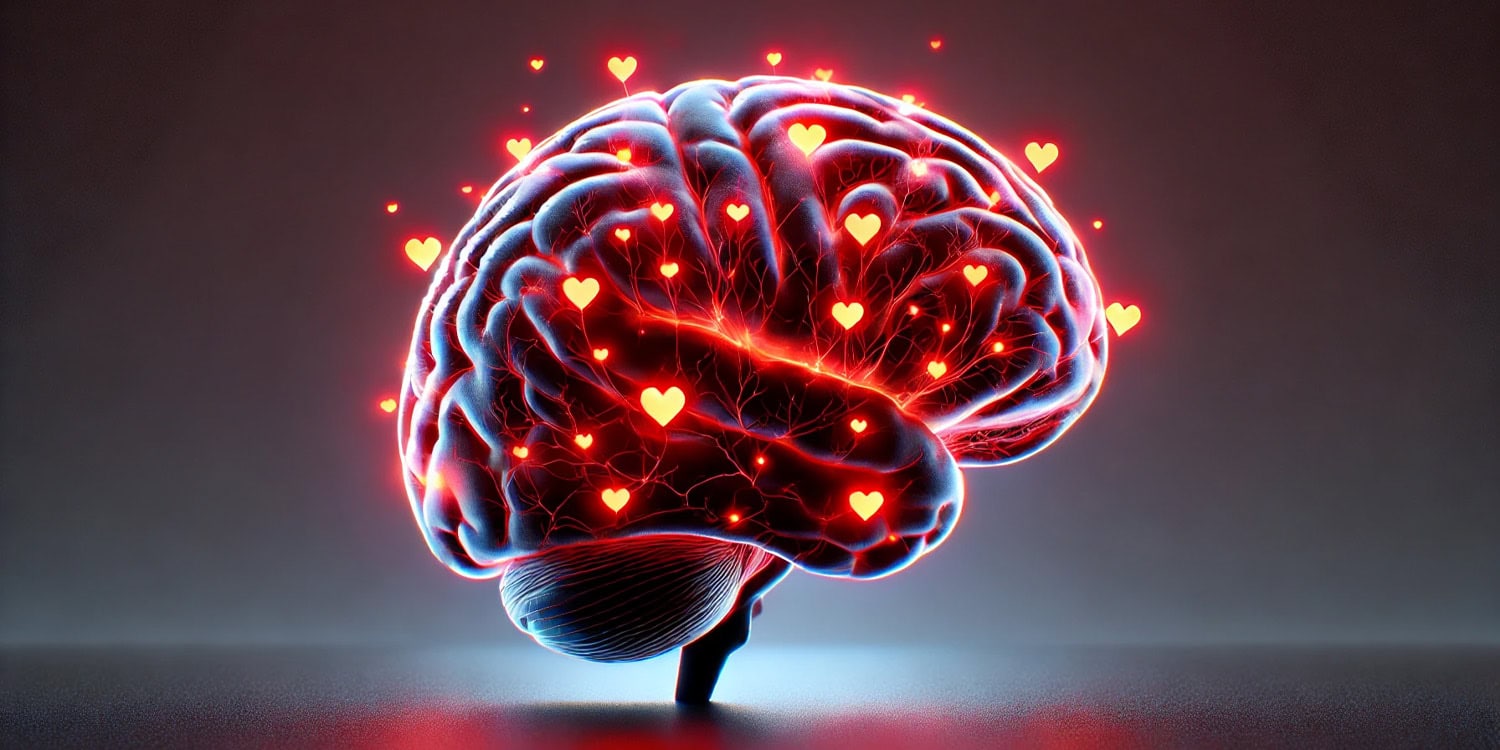A recent study published in Cerebral Cortex has deepened our understanding of how the brain processes six distinct types of love. Using functional magnetic resonance imaging (fMRI), researchers examined the neural activity triggered when people experience love for romantic partners, children, friends, strangers, pets, and nature. The findings revealed that the brain’s response to love varies depending on the type of relationship, highlighting the different neural pathways activated by each form of affection.
Although previous research has established that feelings of romantic and maternal love are closely linked to certain brain regions, such as those involved in reward and attachment, less is known about other forms of love. For instance, love for friends, pets, or nature may engage the brain in different ways. By expanding the focus to multiple types of love, the researchers aimed to uncover whether all forms of love share common neural foundations or if distinct brain networks are involved depending on the object of affection.
The researchers also wanted to explore whether the intensity of love for different objects, like friends versus strangers, is reflected in specific brain activations. This could help explain why certain forms of love feel more powerful or emotionally charged than others, while also contributing to broader theories about human attachment and affiliation.
“My own background is in scriptwriting and philosophy, and I have been working on the concept of love for over a decade,” said study author Pärttyli Rinne, a researcher in the Brain and Mind Laboratory at Aalto University. “I see love as one of the most significant human phenomena both personally and culturally. Yet, love is an understudied topic within the scientific community. Considering the ubiquity of negative social phenomena like hatred, violence, and wars, love is also still poorly understood by the global human community.”
For their study, the researchers recruited 55 healthy adults, consisting of 29 women and 26 men, aged between 28 and 53 years old. All participants reported being in loving relationships, having at least one child, and 27 participants were pet owners. Participants listened to short, pre-recorded audio stories designed to evoke feelings of love for various objects: romantic partners, children, friends, strangers, pets, and nature.
Each story described an everyday situation that concluded with an emotional statement such as “You feel love for your child” or “You love nature.” For comparison, the researchers also included neutral stories describing mundane activities, such as sitting on a bus, where no strong emotional response was expected.
While participants listened to these narratives, their brain activity was measured using fMRI, a technique that detects changes in blood flow to different areas of the brain, providing insights into which regions are more active during specific tasks. After listening to each story, participants were instructed to imagine and focus on the emotions that the story evoked. This allowed the researchers to observe brain activity both during the storytelling and during a period of mental immersion in the feelings of love.
The researchers also gathered behavioral data, asking participants how strongly they felt the emotions described in each story and how similar these feelings were across different objects of love. This helped the team link subjective emotional experiences to the observed brain activity.
“We use state-of-the-art technology to measure what happens in the brain when a person feels love,” Rinne told PsyPost. “We studied many different types of love and were able to show how different types of love activate the brain in different ways. Our results help explain why the word ‘love’ is used in so many different contexts. Our research also offers insights into why we feel stronger affection for those we are close to compared to strangers, even though the underlying brain processes of affection are the same for all types of interpersonal relationships.”
The study found that different types of love engage both shared and distinct regions of the brain. At a general level, all types of love activated areas associated with social cognition, including the medial prefrontal cortex, the temporoparietal junction, and the precuneus. These regions are involved in understanding others’ thoughts and emotions, a process known as theory of mind. This suggests that even when we experience love for non-human objects, like nature, our brain still engages these neural pathways.
However, the intensity and breadth of brain activation differed significantly depending on the type of love. The most widespread and strongest activation occurred when participants experienced love for their romantic partners and children. These forms of love activated the brain’s reward system, including areas such as the striatum and thalamus, which are associated with feelings of pleasure, motivation, and reinforcement. These forms of love also engaged subcortical regions, including parts of the brainstem, which are associated with bodily arousal and emotional regulation, reinforcing their intense emotional nature.
In contrast, love for friends and strangers activated the reward system to a lesser degree. The activation was still present in key brain regions related to social cognition, such as the prefrontal cortex and temporoparietal junction, but it was not as strong or widespread as in romantic or parental love. Love for strangers, in particular, showed the weakest activation in both reward-related areas and brainstem regions.
This diminished activation corresponds with the behavioral findings, where participants reported that love for strangers felt less intense, less arousing, and less pleasurable than love for closer relationships. The neural response to love for strangers was primarily linked to regions involved in empathy and altruism, indicating that while it shares some features with other forms of love, it may be more aligned with feelings of compassion rather than deep emotional attachment.
Love for pets showed an interesting pattern in the data. For participants who were pet owners, love for their pets activated regions related to emotion processing, empathy, and social cognition, similar to interpersonal love. Specifically, the precuneus and posterior cingulate cortex, areas often associated with emotional connection and reflection, were more strongly activated in pet owners compared to non-pet owners.
This suggests that for people who have a strong attachment to their pets, the neural experience of love for animals can closely resemble love for humans. However, for participants without pets, the neural activation was weaker, indicating that personal experiences and relationships can shape how the brain responds to love for different objects.
“I was personally surprised that all the interpersonal love types (i.e. where the object of love is a person: romantic partner, one’s child, friend, stranger) activate so similar brain areas,” Rinne said. “The difference is mainly in the strength of activation, especially in the reward system of the brain such that closer affiliations activate the reward system more intensely.”
“All interpersonal love types activate brain areas associated with social cognition. It was also thrilling to find that in pet owners, love for pets activates these same social brain regions significantly more than in participants without pets. That is, for pet owners love for pets is neurally more resemblant of interpersonal love than for participants without pets.”
Perhaps one of the most distinct findings was related to love for nature. Unlike interpersonal love, love for nature activated brain regions involved in visual and spatial processing, such as the parahippocampal gyrus, which is typically associated with the appreciation of landscapes. This suggests that love for nature might engage more aesthetic and sensory pathways in the brain, rather than the social and emotional networks that are engaged by love for people or pets.
Interestingly, love for nature did not activate areas typically associated with theory of mind, reinforcing the idea that this form of love is fundamentally different from love for living beings. Nonetheless, it still engaged some reward-related areas, indicating that the experience of nature can evoke feelings of pleasure and emotional satisfaction, albeit through different neural pathways than interpersonal love.
The study also explored the differences in brain activation between the storytelling phase, when participants listened to narratives about love, and the imagery phase, when they were asked to immerse themselves in the feeling of love. Across all types of love, the neural activation was stronger during the storytelling phase, particularly in regions associated with auditory processing and narrative comprehension.
However, even during the imagery phase, which involved no external stimuli, significant activation was still observed in brain areas related to social cognition and reward. This suggests that simply imagining feelings of love is enough to engage the brain’s emotional and reward systems, though the activation is less pronounced than when those feelings are triggered by external stimuli.
The study provides important insights into the neural basis of different types of love, but it has some limitations. One key limitation is that all participants were from a relatively homogenous group, living in the same geographic area and sharing similar life circumstances.
“While our cohort of participants is to date the largest in a neuroscientific study on love, the generalizability of our results is limited by the demographics of our sample,” Rinne noted. “Love is a complex and multifaceted set of biologically grounded and culturally modified phenomena, and further cross-cultural research is still required for a better understanding of how cultural and demographic factors influence various feelings of love and their correlates in the human brain.”
The researchers suggest that future studies should explore the neural basis of love across different cultures to see whether the findings hold true in diverse populations. It would also be interesting to examine how love for abstract objects, such as nature or spiritual beings, might vary in different cultural contexts. For instance, love for nature might be experienced differently in cultures where people have a closer relationship with the environment compared to those in urbanized settings.
“We are currently interested in cross-cultural measurements of experiences of love,” Rinne said. “It would be fascinating to understand whether subjective experiences of different types of love are cross-culturally universal, what types of cultural differences may exist between these experiences, and what the global neural correlates of love are based on cross-cultural neuropsychological research.”
The study, “Six types of loves differentially recruit reward and social cognition brain areas,” was authored by Pärttyli Rinne, Juha M Lahnakoski, Heini Saarimäki, Mikke Tavast, Mikko Sams, and Linda Henriksson.




